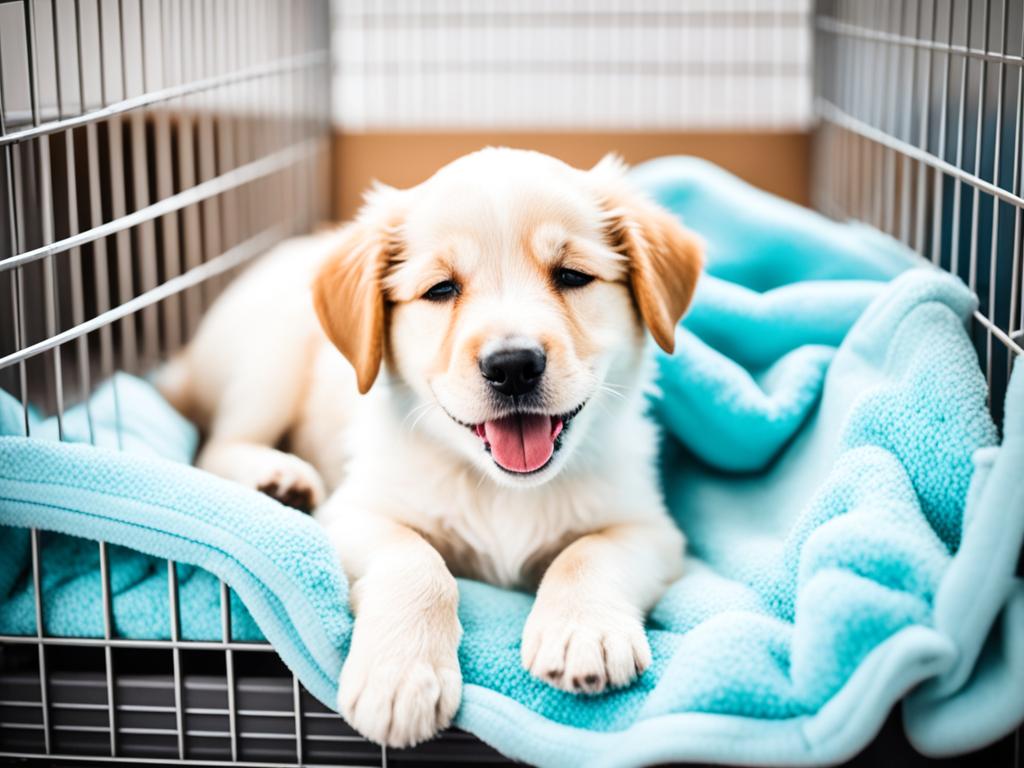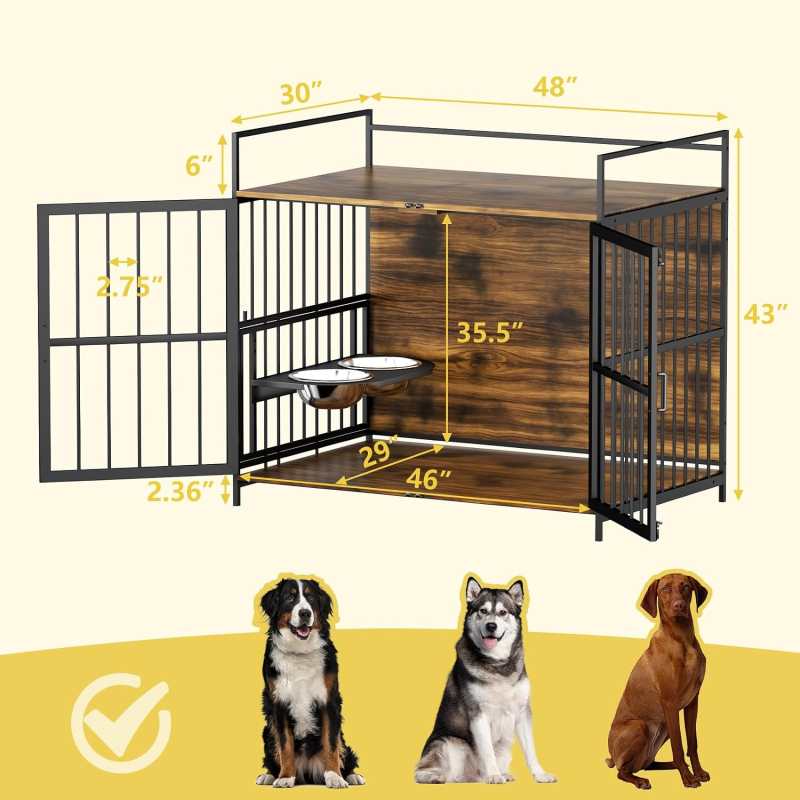
Did you know that crate training is not only beneficial for potty training but also helps keep your puppy safe and provides them with a comfortable retreat? It’s true! Crate training is a process that helps your puppy learn to spend time in their crate, seeing it as their own personal space. This comprehensive guide will provide you with step-by-step instructions on how to successfully crate train your puppy, making the process easy and enjoyable for both of you.
When done correctly, crate training offers numerous benefits for both you and your furry friend. It gives your puppy a space of their own, aids in potty training, and creates a safe zone for them during injuries or medical procedures. Proper crate training allows your puppy to feel calm and secure, eliminating the need for constant supervision.
To successfully crate train your puppy, you’ll need a few essentials. This includes choosing the appropriate type and size of crate, such as plastic or wire crates, and ensuring your puppy has enough space to stand, turn around, and lie down comfortably. You’ll also need bedding, treats, and toys to make the crate inviting and enjoyable for your puppy.
Key Takeaways:
- Crate training provides a safe and comfortable space for your puppy.
- It is not cruel and helps with potty training.
- Choose the right type and size of crate for your puppy.
- Make the crate inviting with bedding, treats, and toys.
- Introduce the crate gradually and be patient throughout the training process.
Benefits of Crate Training
Crate training offers several benefits for both you and your puppy. Let’s explore why crate training is an essential part of your puppy’s development and well-being.
Gives Your Puppy a Space of Their Own
Crate training provides your puppy with a safe and cozy space that they can call their own. It becomes their sanctuary, a place where they can retreat to when they need some alone time or feel overwhelmed. Having a designated space helps your puppy feel secure and reduces anxiety.
Helps with Potty Training
One of the key benefits of crate training is its contribution to potty training. Puppies have a natural instinct to keep their sleeping area clean, making crates an effective tool in teaching them bladder and bowel control. By confining them to the crate when unsupervised, you can prevent accidents and create a consistent routine for bathroom breaks.
Keeps Them Safe
Crates provide a safe environment for your puppy, especially when they are unsupervised. It prevents them from exploring potentially dangerous areas or getting into mischief that could endanger their well-being. In the crate, your puppy is secure and protected from household hazards.
Provides a Recovery Zone
During injuries or medical procedures, a crate can serve as a comfortable and peaceful recovery zone for your puppy. It helps restrict their movement and prevents them from aggravating their condition. With a cozy bed and soothing toys, the crate becomes a welcoming space for healing.
Promotes Calmness and Security
Contrary to the misconception that crate training is cruel, when done properly, it allows your puppy to feel calm and secure. Dogs are den animals by nature, and crates replicate the secure, enclosed spaces they seek for rest. By associating the crate with positive experiences and using it as a tool for relaxation, your puppy will come to appreciate their crate as a peaceful retreat.
Remember, crate training is a gentle and effective method that benefits both you and your puppy. By incorporating crate training into your puppy’s routine, you are setting them up for success and creating a harmonious living environment.
Crate Training Supplies
To successfully crate train your puppy, you will need the right supplies. Choosing the appropriate type and size of crate for your puppy is essential. There are different options available, such as plastic crates and wire crates. It’s important to pick the correct size to ensure your puppy can stand, turn around, and lie down comfortably.
Additionally, you will need bedding, treats, and toys to make the crate a comfortable and enjoyable space for your puppy. The bedding should be soft and cozy, providing a warm and inviting environment. Treats can be used as rewards during the crate training process, reinforcing positive behavior. Toys can help keep your puppy entertained and stimulated while in the crate.
| Supplies | Description |
|---|---|
| Crate | The crate should be the appropriate size for your puppy, allowing them to stand, turn around, and lie down comfortably. |
| Bedding | Choose soft and comfortable bedding that provides warmth and coziness for your puppy. |
| Treats | Use tasty treats to reward and reinforce positive behavior during crate training sessions. |
| Toys | Offer engaging and interactive toys to keep your puppy entertained and stimulated while in the crate. |
Having the right crate training supplies will make the process more enjoyable for your puppy and increase the likelihood of successful crate training. Remember to introduce these supplies gradually, creating a positive association with the crate, and rewarding your puppy for their progress.
Top 5 Dog Crates
- MidWest Homes for Pets iCrate (Best Overall)

- Pros: Durable, escape-proof, affordable, various sizes available, easy to assemble, divider panel included (optional purchase for some sizes)
- Cons: Not as visually appealing as some other options
- Amazon Basics Single-Door Metal Dog Crate (Best Budget)

- Pros: Affordable, durable, easy to assemble and clean, multiple sizes available
- Cons: No divider panel included, not fancy looking
- Petsfit Soft Dog Crate (Best Soft Crate)

- Pros: Lightweight, portable, good for travel, easy to clean, machine washable liner
- Cons: May not be as durable as metal crates, not suitable for escape artists
- ZENY 30/36/42 Inch Dog Crate Double Door (Best Value)

- Pros: Affordable, durable, easy to assemble and clean, double doors for easy access, multiple sizes available
- Cons: May not be as escape-proof as some other options
- beeNbkks Furniture Style Double Door End Table Dog Crate (Best Crate Furniture)

- Pros: Doubles as a piece of furniture, stylish design, multiple sizes available, escape-proof
- Cons: More expensive than other options, may not be suitable for all home decor styles
Remember, the best dog crate for you will depend on your dog’s size, temperament, and your individual needs. Be sure to consider all of the factors before making a purchase.
OUR TOP STYLE PIC IS THE ROOMTEC 48 Inch Dog Crate FULL REVIEW HERE

Crate Location
The location of the crate is an important factor in the success of crate training. Choosing the right spot can create a positive environment for your puppy. Here are some tips to consider:
1. Quiet Area
Place the crate in a quiet area of your home, away from heavy foot traffic and excessive noise. This will help your puppy feel secure and minimize distractions during crate training.
2. Nighttime Considerations
At night, it’s crucial to position the crate in a location near you. This ensures you can hear your puppy if they need to go out for a potty trip. If keeping the crate in your bedroom isn’t feasible, consider using a dog monitor to stay connected with your puppy’s needs.
3. Multiple Crates
In some cases, having two crates can be beneficial. Consider having one crate in a common area where your puppy spends most of their time. This will allow them to feel included in family activities. Additionally, having a separate crate where your puppy sleeps at night can provide a sense of comfort and routine.
Crate training is a process that requires patience and consistency. By strategically placing the crate in an appropriate location, you can create a conducive environment for successful crate training. Remember to make the crate a comfortable and inviting space for your puppy, and avoid using it for punishment or extended periods without exercise or human interaction.
How to Crate Train a Puppy: Step by Step
Crate training is an essential process to ensure your puppy feels comfortable and safe in their crate. By following a step-by-step approach, you can effectively crate train your puppy and establish positive associations with their crate.
- Introduce the crate: Begin by introducing your puppy to the crate as a positive and safe space. Leave the crate door open and place treats or toys inside to encourage your puppy to explore and enter the crate willingly.
- Feeding in the crate: Gradually transition to feeding your puppy inside the crate. Start by placing their food bowl near the crate, then move it just inside the crate, and eventually place it at the back of the crate. This helps your puppy associate the crate with positive experiences and rewards.
- Practice with longer crating periods: Once your puppy is comfortable eating in the crate, you can start closing the crate door for short periods while they eat. Increase the duration gradually, making sure to stay nearby and provide reassurance. This step helps your puppy become accustomed to being in the crate with the door closed.
- Gradually leave them alone: Once your puppy is comfortable staying in the crate with the door closed, begin leaving the room for short periods. Start by stepping just outside the room and gradually increase the time away. This helps your puppy adjust to being alone in the crate without feeling anxious or stressed.
Consistency is key in crate training. Ensure that you follow the same routine every time and maintain a positive and calm atmosphere. Avoid using the crate for punishment, as this can create negative associations and make crate training more challenging.
Remember not to leave your puppy in the crate for extended periods without exercise or human interaction. Regular playtime, walks, and socialization are vital for their overall well-being.
By following these step-by-step methods, you can successfully crate train your puppy and provide them with a secure and comfortable space they can call their own.
| Benefits | Description |
|---|---|
| 1. Potty training | Helps in potty training by teaching your puppy to hold their bladder and bowel movements. |
| 2. Safety | Provides a safe space for your puppy when you are unable to supervise them. |
| 3. Comfort | Gives your puppy a cozy and secure retreat where they can rest and relax. |
| 4. Travel | Makes traveling with your puppy easier and safer. |
| 5. Prevents destructive behavior | Reduces the likelihood of destructive behavior when your puppy is unsupervised. |
Tips and Tricks
Crate training your puppy can be a rewarding experience, but it’s important to have some tips and tricks to make the process smoother. By following these guidelines, you can avoid common mistakes and ensure successful crate training for your furry friend.
Making the Crate Inviting
One of the keys to successful crate training is to make the crate a welcoming and comfortable space for your puppy. Use treats, toys, and soft bedding to create a positive association with the crate. Place your puppy’s favorite toys or a cozy blanket inside to make it inviting. Reinforce positive behavior by praising and rewarding your puppy when they willingly enter the crate.
Positive Reinforcement
Positive reinforcement is a powerful tool when it comes to crate training. Reward your puppy with treats or praise whenever they exhibit desired behavior, such as entering the crate willingly or staying calm inside. This will help your puppy associate the crate with positive experiences, making them more willing to spend time in it.
Gradual Duration Increase
When starting crate training, begin with short periods of time and gradually increase the duration. This will help your puppy adjust to being in the crate without feeling stressed or anxious. Start with just a few minutes and gradually work your way up to longer intervals. Always monitor your puppy’s behavior and adjust the duration accordingly. Remember, crate time should never be excessive or leave your puppy feeling isolated.
Avoid Common Mistakes
There are some common crate training mistakes that should be avoided to ensure the process goes smoothly. Rushing the training process can lead to confusion and resistance from your puppy. Take your time and be patient. Additionally, using the crate as a form of punishment can create negative associations and make your puppy fearful of the crate. Lastly, avoid leaving your puppy in the crate for extended periods without exercise or human interaction. The crate is not a substitute for quality time with your furry friend.
Crate Training Tips
- Make the crate inviting with treats, toys, and comfortable bedding.
- Use positive reinforcement to reward desired behavior.
- Gradually increase the duration of crate time.
By following these tips and avoiding common mistakes, you can ensure successful crate training for your puppy. Remember, patience and consistency are key. Crate training can provide your puppy with a safe and comfortable space, helping them feel secure and happy.
Crating Caution
While crate training has many benefits, it’s essential to be cautious and use the crate correctly. Avoid these crate training mistakes to ensure a positive experience for your puppy:
- Using the crate for punishment: The crate should be a safe and comforting place for your puppy, not a place of punishment. Avoid using the crate as a form of discipline to maintain a positive association.
- Leaving puppies under 6 months in the crate for too long: Puppies have limited bladder control and shouldn’t stay in a crate for more than three or four hours at a time. Make sure to provide regular potty breaks to avoid accidents and discomfort.
- Stopping crate training too soon: Crate training should continue until your puppy is able to be alone in the house without accidents or destructive habits. Gradually increase the duration of crate time to build their independence.
It’s important to create a comfortable and inviting crate environment for your puppy. Provide a cozy bed and leave the crate door open when you’re home, allowing your puppy to enter and use the crate as a safe space when they need it.
“Proper crate training is essential for your puppy’s well-being and development. Avoid common crate training mistakes to ensure a positive and successful experience for your furry friend.”
Conclusion
Crate training your puppy made easy: a step-by-step guide provides you with a valuable process to simplify potty training and create a safe and comfortable space for your furry friend. By following this comprehensive guide and utilizing the right supplies and techniques, you can successfully crate train your puppy and enjoy the numerous benefits it offers.
Remember, patience and consistency are key throughout the crate training process. By gradually introducing the crate, using positive reinforcement, and allowing your puppy to adjust at their own pace, you can ensure a positive association with the crate.
With crate training, you not only provide a space for your puppy to feel secure and relax but also aid in potty training and keep them safe from potential dangers. So, start crate training your puppy today and witness the positive results it brings to both you and your furry companion.











